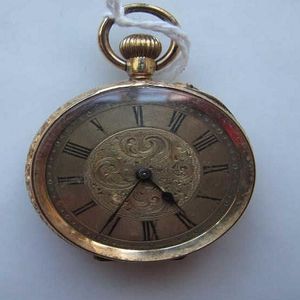Enamel Verge Watch with Miniature Painting
You must be a subscriber, and be logged in to view price and dealer details.
Subscribe Now to view actual auction price for this item
When you subscribe, you have the option of setting the currency in which to display prices to $Au, $US, $NZ or Stg.
- Polychrome - Made or finished in many colours. For furniture, it is used to indicated a painted finish.
- Date Aperture - A date aperture is a cut out section in the face of a watch or clock, displaying the day of the month.
- Foliate - Decorated with leaves or leaf-like forms.
- Embossed / Repousse - Embossing, also known as repousse, is the technique of decorating metal with raised designs, by pressing or beating out the design from the reverse side of the object.It is the opposite of chasing, where the decoration is applied from the front. An embossed or repoussed object may have chasing applied to finish off the design.
- Movement - The technical name for the workings of a clock or watch, and does not include the dial or case.
- Pair Cased - A pair cased watch is one with a double case. The movement is encased, and for additional protection this is fitted into an outer case.
- Circa - A Latin term meaning 'about', often used in the antique trade to give an approximate date for the piece, usually considered to be five years on either side of the circa year. Thus, circa 1900 means the piece was made about 1900, probably between 1895 and 1905. The expression is sometimes abbreviated to c.1900.
- Fusee - The fusee movement was used in clocks and pocket watches from the mid 17th century. The fusee is a cone shaped drum within the works that is linked to the barrel of the spring, usually by a length of chain.
As the mainspring loses its tension over time, the cone shaped barrel compensates for this by increasing the tension, by pulling the mainspring tighter, thus ensuring the time remains constant.
Use of the fusee in clocks was superseded by the "going barrel" in the mid 19th century and for pocket watches at the beginning of the 19th century.
The fusee continued to be used in marine chronometers until the 1970s.
This item has been included into following indexes:
-
pocket watches, case type
- enamelled decoration 148
- pair cased 143
- pocket watches, period - Georgian 240
Visually similar items

An 18th century silver pair case verge pocket watch by J. Wilders, silver dial with engraved Arabic and Roman numerals, dot half hour markers, themed centre with date above 6 o'clock, on fusee movement with pierced engraved balance bridge, Egyptian pillars

Joseph Johnson Liverpool An 18ct gold openfaced pocketwatch mvt 4267 circa 1850, english fusee Massey lever movement signed Josh Johnson diamond endstone, gold engine-turned dial, Roman numerals, engine turned case engraved with initial W at centre, reeded

A small Swiss open face pocket watch, c.1880, stamped 18K with gold face and Roman numerals. The back cover with engine turned decoration, Stauffer cylinder movement. Diameter 40 mm.

Antique 18kt gold ladies pocket watch works
